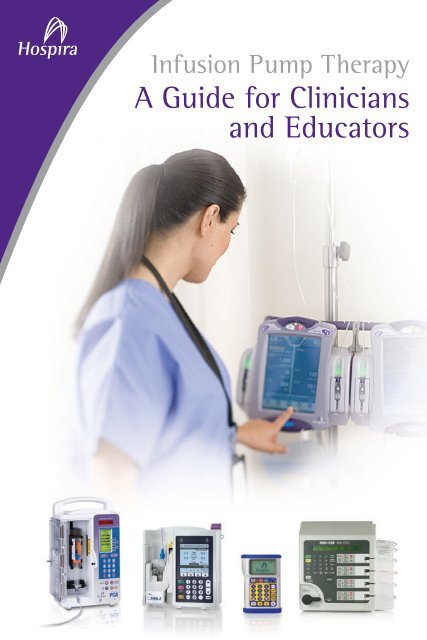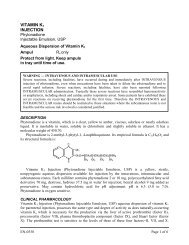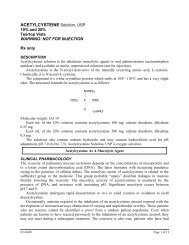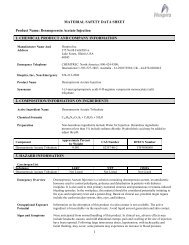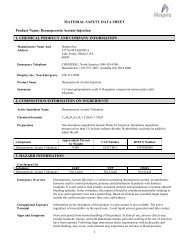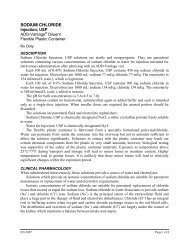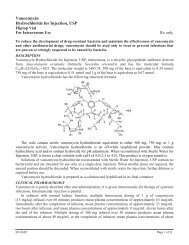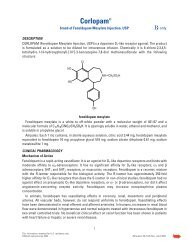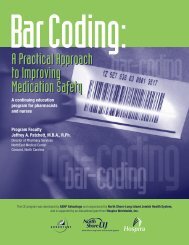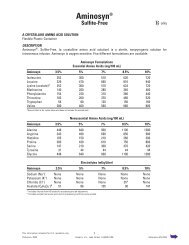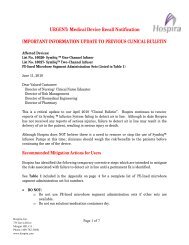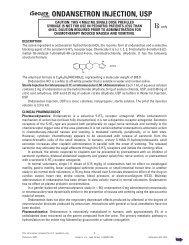Infusion Pump Therapy A Guide For Clinicians And - Hospira
Infusion Pump Therapy A Guide For Clinicians And - Hospira
Infusion Pump Therapy A Guide For Clinicians And - Hospira
Create successful ePaper yourself
Turn your PDF publications into a flip-book with our unique Google optimized e-Paper software.
<strong>Infusion</strong> <strong>Pump</strong> <strong>Therapy</strong><br />
A <strong>Guide</strong> for <strong>Clinicians</strong><br />
and Educators
Denise Macklin, BSN, RN<br />
About the Author<br />
Denise Macklin, BSN, RN, is the<br />
President and founder of Professional<br />
Learning Systems, Inc. (PLS)<br />
and the editor-in-chief of ceuzone.<br />
com, a nursing continuing education<br />
Internet site. PLS’s programs and<br />
online CE off erings are being used to<br />
educate nurses worldwide. She has<br />
over 30 years of nursing experience<br />
with 23 years in the specialty of IV<br />
<strong>Therapy</strong>. She is the recipient of the<br />
Suzanne Herbst Award for vascular<br />
access and a research grant related<br />
to vascular access education from<br />
the National Institute for Nursing<br />
Research. She has lectured around<br />
the United States on a wide<br />
variety of IV <strong>Therapy</strong> topics. She<br />
has published articles in various<br />
publications, including Oncology<br />
Nurse <strong>For</strong>um, Journal of Vascular<br />
Access, American Journal of<br />
Nursing, Nursing Management and<br />
Dimensions of Critical Care. She<br />
has published six nursing textbooks<br />
through Eslsevier with one specifi -<br />
cally on IV therapy practice.<br />
<strong>Infusion</strong> <strong>Pump</strong> <strong>Therapy</strong><br />
A <strong>Guide</strong> for <strong>Clinicians</strong><br />
and Educators<br />
Table of Contents<br />
1. Basics of <strong>Infusion</strong> <strong>Therapy</strong> .................................................. 1<br />
2. Keep It Simple: Safe and Eff ective <strong>Infusion</strong> <strong>Therapy</strong> .. 5<br />
3. What Factors Aff ect the Physics of Flow? ..................... 9<br />
A. Rate................................................................................<br />
9<br />
B. Pressure ...................................................................... 11<br />
C. Resistance...................................................................<br />
17<br />
D. Viscosity......................................................................<br />
18<br />
E. Length ......................................................................... 19<br />
F. Internal Diameter ..................................................... 20<br />
G. Infi ltration..................................................................<br />
23<br />
4. Frequently Asked Questions About<br />
Pounds per Square Inch (PSI) ........................................... 25<br />
5. What Is Low Flow Continuity and How Does It<br />
Aff ect the Care of the Patient? ....................................... 28<br />
6. Concurrent Flow: Demystifying the Complexity<br />
of Multiple <strong>Infusion</strong>s .......................................................... 31<br />
7. Conclusion..............................................................................<br />
36<br />
8. Glossary .................................................................................. 37<br />
9. Bibliography .......................................................................... 38
Introduction<br />
The purpose of this booklet is to provide clinicians<br />
and educators some basic principles of infusion<br />
therapy, describe principles that aff ect infusions and<br />
delineate specifi c interventions to troubleshoot some<br />
common clinical problems. The material in the fi rst<br />
two sections provides a general overview, while the<br />
remaining chapters contain more specifi c information<br />
to help users become familiar with the principles<br />
behind infusion pumps and accurate delivery of<br />
intravenous medication/therapy.<br />
LifeCare PCA®<br />
<strong>Infusion</strong> System<br />
Plum A+®<br />
<strong>Infusion</strong> System<br />
Omni-Flow 4000® Plus<br />
<strong>Infusion</strong> System<br />
GemStar®<br />
<strong>Infusion</strong> System<br />
Section 1<br />
Basics of <strong>Infusion</strong> <strong>Therapy</strong><br />
The infusion of solutions into a patient’s venous<br />
system is central to today’s therapeutic regimens<br />
and occurs in many settings: inpatient, outpatient,<br />
physician offi ces and at home. Patients receive<br />
infusions through a myriad of devices: peripheral<br />
venous catheters, central venous catheters, PICCs<br />
(peripherally inserted central catheters), implanted<br />
ports and epidural catheters, to name a few. Each site,<br />
solution, medication, device and method of delivery<br />
is chosen specifi cally for that patient and needs to<br />
be evaluated on an ongoing basis (i.e., the patient’s<br />
therapy may change, IV sites need to be rotated, sites<br />
may infi ltrate, etc.). Patients can receive IV therapy<br />
on a continuous or intermittent basis and may have<br />
multiple IV sites with diff erent types of catheters.<br />
While gravity infusions are still used in some care<br />
settings—such as emergency departments, obstetrics<br />
and clinics—most care settings utilize electronic<br />
infusion devices. <strong>And</strong> with the advent of home<br />
infusion therapy, more caregivers are learning how to<br />
administer medications using home infusion pumps.<br />
In order to understand any infusion pump, it is<br />
helpful to understand the anatomical factors that<br />
impact successful infusions. Veins and arteries<br />
1
diff er in their ability to expand—veins being more<br />
compliant than arteries. Other diff erences between<br />
these vessels include wall thickness (veins are thinner<br />
than arteries) and the presence of valves (veins alone<br />
have valves). Blood moving through the circulatory<br />
system exerts pressure on the walls of veins and<br />
arteries, and since veins are more compliant the fl ow<br />
rate is slower. Vascular pressure is lower in veins. The<br />
venous pressure must be overcome by the pump for<br />
successful infusion.<br />
5 10 15 20 25<br />
Venous pressure in<br />
supine patient<br />
(mmHg)<br />
Figure 1: Pressures and the Human Body<br />
100<br />
110<br />
120<br />
130<br />
140<br />
150<br />
160<br />
170<br />
180<br />
190<br />
Arterial pressure<br />
(mmHg)<br />
0<br />
10<br />
20<br />
30<br />
40<br />
50<br />
60<br />
70<br />
80<br />
90<br />
Venous pressure<br />
(mmHg)<br />
Other Factors That Impact <strong>Infusion</strong> Are<br />
• Quality of vasculature: This may vary by patient<br />
depending upon the disease process. <strong>For</strong> instance,<br />
the peripheral veins of a patient in shock are<br />
constricted, may be very diffi cult to access and will<br />
experience many hemodynamic changes during<br />
treatment. Cardiac patients have increased potential<br />
for venous spasm and the presence of edema can<br />
make venous access diffi cult. Peripheral neuropathy<br />
associated with diabetes limits the patient’s ability<br />
to feel and to acknowledge early symptoms of<br />
phlebitis or infi ltration.<br />
• Age of the patient: Access, medication dosage and<br />
fl uid volume are diff erent for a child than an adult.<br />
Geriatric patients require special attention as skin<br />
integrity, vessel elasticity, fl uid balance and muscle<br />
mass change with advancing age. All of these diff erences<br />
aff ect site preparation, catheter selection, vein<br />
visualization and stabilization, catheter stabilization,<br />
dressing management and fl uid administration.<br />
• IV Solution/Medication: The choice of solution or<br />
medication also aff ects the selection of the vein<br />
and access device. Medications such as Mannitol<br />
require special fi lters, and some medications that<br />
are more irritating require use of a larger vein to<br />
promote hemodilution. Other medications can only<br />
be infused via an infusion pump because they must<br />
be administered in precise doses.<br />
2 3
A complete patient assessment prior to initiating an<br />
infusion is essential for the clinician to determine<br />
the potential for complications based on the therapy<br />
prescribed. This “risk” assessment assists the clinician<br />
in developing a plan of care that minimizes complication<br />
occurrence. Patient age and condition, as well<br />
as the medication prescribed, are the most common<br />
factors impacting outcome. Pediatric, geriatric and<br />
critically ill patients require special attention to<br />
catheter and site selection to achieve positive patient<br />
outcomes. Some vesicant medications, such as total<br />
parenteral nutrition or those containing a high<br />
amount of dextrose, require central venous access.<br />
Because the clinician is responsible for the infusion<br />
process, selecting the administration set, the appropriate<br />
pump and add-ons (i.e., fi lter and extension)<br />
requires an organized approach.<br />
Section 2<br />
Keep It Simple: Safe and<br />
Eff ective <strong>Infusion</strong> <strong>Therapy</strong><br />
<strong>Clinicians</strong> today are faced with numerous decisions<br />
on a daily basis. Administering eff ective and<br />
safe infusion therapy involves assessment of the<br />
relationship between the patient, the infusion method<br />
and the clinical outcome. Some basic questions for<br />
clinicians to ask include the following:<br />
Patient<br />
• Current status?<br />
• Change in the patient’s status?<br />
• Why this infusion therapy/medication?<br />
• If a change occurred in the patient’s blood pressure/<br />
condition, should the PSI alarm on the pump be<br />
reset? See Section 3.b (Pressure) for more<br />
information on pressure/PSI.<br />
<strong>Infusion</strong> Method/<strong>Therapy</strong><br />
• Has the catheter been assessed?<br />
• Has the entire infusion set-up been assessed from<br />
the catheter insertion site to the solution container?<br />
4 5
• Is the tubing free of kinks? Is the IV catheter free<br />
of kinks?<br />
• Is the catheter size appropriate for the infusion?<br />
• Is there enough solution left in the container to<br />
ensure delivery to the patient and to keep the<br />
vein open?<br />
• PSI:<br />
1. To what PSI limit is the pump set?<br />
2. Current PSI of the patient? ( see Figure 1)<br />
3. Does the PSI limit on the pump make sense given<br />
the current PSI of the patient, the viscosity of the<br />
solution and the infusion rate?<br />
4. If there has been a recent change in IV rate<br />
(increase), will this aff ect the current PSI setting of<br />
the pump?<br />
• Is this the correct pump for this patient?<br />
• <strong>For</strong> medications that require a fi lter, is there a fi lter<br />
incorporated in the IV administration set-up? Is it<br />
the correct fi lter size?<br />
•<br />
Precipitates visible in the tubing?<br />
• Tubing free of air?<br />
• Is the pump battery charged or plugged into an<br />
AC power source? If the patient is sent to another<br />
area, is there enough charge left on the battery to<br />
continue infusing for the amount of time needed?<br />
• If the IV insertion site was changed, was the<br />
tourniquet removed from the patient?<br />
• If the device has safety software, is the unit-specifi c<br />
medication library being utilized?<br />
• Did someone else have access to the pump?<br />
Clinical Outcome<br />
• What is the goal of treatment/expected clinical<br />
outcome for this patient?<br />
• Has the patient achieved the expected outcome<br />
within the anticipated amount of time?<br />
• If not, what may have prevented this from<br />
happening?<br />
• Is the IV access intact? (i.e., no clotting or infi ltration)<br />
Is the correct solution being infused?<br />
6 7<br />
•<br />
•<br />
Is the solution infusing at the prescribed rate?<br />
• Have the orders been checked to determine if any<br />
changes in IV therapy were made?<br />
• Is there anything that may be interfering with<br />
the infusion?<br />
• Is the medication compatible with the other<br />
solution(s) infusing through the same IV administration<br />
set?
• If the outcome has not been reached, has a new<br />
plan of care been formulated in conjunction with<br />
the medical team?<br />
The above review is useful when a complete<br />
assessment of the overall therapy is indicated (i.e.,<br />
initiation of a new therapy, change of shift, new<br />
admissions, transfers, etc.). When infusion pumps<br />
alarm, an assessment is required to resolve the issue<br />
in a timely manner. Keeping the patient, the infusion<br />
therapy and the clinical outcome in mind assists the<br />
clinician in achieving optimal patient outcomes.<br />
Section 3<br />
What Factors Aff ect the<br />
Physics of Flow?<br />
Delivering safe and eff ective therapy to a patient<br />
remains the caregiver’s responsibility. While the<br />
intelligent pumps with safety software promote<br />
safe medication delivery, the clinician needs to be<br />
aware of the principles governing the use of the<br />
pump in order to deliver the best outcome for the<br />
patient. An understanding of the physics of fl ow is<br />
helpful to safely use all the available pump options,<br />
including selecting the appropriate device; delivering<br />
the indicated therapy problem free; evaluating and<br />
altering parameters; and assessing the fl uid pathway.<br />
Factors that aff ect the physics of fl ow are comprised<br />
of the following:<br />
A. Rate<br />
Defi nition: Fluid fl ow rate (FR) occurs as a result of<br />
the relationship of pressure (P) and resistance (R).<br />
FR = P<br />
R<br />
8 9
Principle: Flow rate impacts resistance and resistance<br />
impacts the amount of pressure required to<br />
achieve the fl ow rate.<br />
Clinical Consideration: The following principles<br />
apply to fl ow rates:<br />
• High-resistance systems require the most amount of<br />
pressure (e.g., infusing into a hypertensive patient<br />
with left ventricular hypertrophy or pulmonary<br />
hypertension).<br />
• High fl ow rates in low resistance systems will require<br />
less pressure than in high resistance systems (e.g.,<br />
infusing fl uid rapidly into a hypotensive patient<br />
in shock).<br />
• Low fl ow rates in high resistance systems will<br />
require less pressure than high fl ow rates (e.g.,<br />
infusing at the Keep Vein Open [KVO] rate into the<br />
hypertensive patient).<br />
• Low fl ow rates in low resistance systems will require<br />
the least amount of pressure. <strong>For</strong> example, KVO rate<br />
into a hypotensive patient.<br />
Troubleshooting: Repeated distal occlusion alarms<br />
can be frustrating. Understanding pressure and<br />
resistance enables the practitioner to minimize<br />
their occurrence and successfully eliminate them<br />
by understanding a little physics and basic pump<br />
technology. The practitioner can then compare<br />
the prescribed fl ow rate with the resistors to<br />
fl ow in order to identify the best pump pressure<br />
setting for successful infusion. When the pump<br />
pressure is set properly, distal occlusion alarms<br />
are minimized.<br />
B. Pressure<br />
Defi nition: Pressure (P) is a measure of the force<br />
(F) applied to overcome resistance in a system,<br />
across a given area (A).<br />
P = F<br />
A<br />
The area is the internal fl uid pathway or internal<br />
diameter (tubing, add-ons and catheter).<br />
Pressure is the<br />
result of force<br />
and is measured<br />
in either PSI<br />
(pounds per<br />
square inch)<br />
or mmHg<br />
(millimeters of<br />
mercury).<br />
Figure 2.<br />
Cannula<br />
IV fluid pressure ><br />
vascular backpressure<br />
10 11<br />
Vein
Principle: A pressure gradient between the IV<br />
solution container and the venous pressure<br />
is necessary for fl ow to occur. The gradient<br />
depends on static pressure (height of the solution<br />
container in relation to the patient’s heart) and<br />
the patient’s activity (blood pressure is lower<br />
when the patient is lying down vs. standing<br />
and walking) and dynamic pressure (resistance<br />
generated by the fl uid fl owing through the<br />
IV system). The infusion pump is a source of<br />
constant force that produces a constant fl ow<br />
rate, with the force exerted equal to the rate<br />
times the amount of resistance existing within<br />
the system. The PSI threshold is the PSI limit set<br />
either by the manufacturer or the practitioner.<br />
This threshold alerts the practitioner when the<br />
required force exerted by the pump has reached<br />
the threshold—increased resistance necessitates<br />
an increase in force.<br />
Clinical Consideration: With gravity infusions,<br />
gravity alone is the force. However, with an<br />
infusion pump, the pump applies the force<br />
to move the fl uid. The infusion pump is more<br />
sensitive to changes in the fl uid pathway’s<br />
resistance than gravity systems.<br />
Vascular<br />
backpressure<br />
12 13<br />
Figure 3.<br />
Vein<br />
Pressure on<br />
column of fluid<br />
Cannula<br />
Resistance<br />
<strong>Infusion</strong> pumps utilize diff erent mechanisms<br />
to infuse the fl uid. Some use a cassette system<br />
where a fl uid volume is pulled into a chamber<br />
and then pushed out of the chamber at the<br />
prescribed rate (e.g., the Omni-Flow 4000® Plus,<br />
Plum A+®, GemStar®, Symbiq®). The internal<br />
software of the pump assures delivery accuracy.<br />
Resistance within the fl uid pathway is dependent<br />
upon the pathway length, the internal diameter<br />
of the pathway and the viscosity of the fl uid (full<br />
description below).<br />
Pressure is dynamic in response to changes in<br />
resistance. A distal occlusion alarm occurs when<br />
the PSI threshold has been reached. While an<br />
occluded catheter may be the source of the resistance,<br />
the distal occlusion alarm does not specifi -<br />
cally identify the exact cause.
Other possible causes include kinked tubing,<br />
a tourniquet left on a patient after obtaining<br />
IV access or a change in the patient’s position,<br />
resulting in pressure on the tubing.<br />
Common Pressures<br />
Pressure<br />
50 mmHg =<br />
approximately<br />
1 PSI<br />
Distal Occlusion<br />
Alarm Settings<br />
(PSI)<br />
Distal Occlusion<br />
Alarm Settings<br />
(~mmHG)<br />
Peripheral 0.2 – 0.6 10 – 30<br />
Central Venous 0.1 – 0.4 5 – 20<br />
Plum A+®<br />
<strong>Infusion</strong> System<br />
GemStar®<br />
<strong>Infusion</strong><br />
System-Low<br />
GemStar®<br />
<strong>Infusion</strong><br />
System-Medium<br />
GemStar®<br />
<strong>Infusion</strong><br />
System-High<br />
Symbiq®<br />
<strong>Infusion</strong> System<br />
LifeCare PCA®<br />
<strong>Infusion</strong> System<br />
Omni-Flow<br />
4000® Plus<br />
<strong>Infusion</strong> System<br />
PSI<br />
Increment<br />
(PSI)<br />
Default<br />
Setting<br />
(PSI)<br />
Up to 15 Up to 750 1.0 6<br />
7 (+/- 5) 350 (+/- 250) 1.0 26<br />
(+/-14)<br />
12 (+/- 8) 600 (+/- 400) 1.0 26<br />
(+/-14)<br />
26 (+/-14) 1300 (+/- 700) 1.0 26<br />
(+/-14)<br />
Up to 15 Up to 750 0.5 6<br />
15 (+/-5) 750 (+/- 250) 15<br />
Up to 12 Up to 600 1.0 10<br />
Power injectors 300-1000+ 15,000 – 50,000 +<br />
Table 1.<br />
Some infusion pumps allow the PSI/mmHg<br />
threshold to be set/altered by the practitioner;<br />
setting the PSI limit correctly helps to minimize<br />
downstream or distal occlusion alarms. It may<br />
seem, for instance, that the lowest PSI setting<br />
would always be the safest choice. However,<br />
since greater force is required to overcome<br />
increased dynamic pressure in a fl uid pathway,<br />
high resistance systems with a low PSI setting<br />
would yield the greatest number of distal<br />
occlusion alarms. With low resistance systems,<br />
a low PSI setting would not increase occlusion<br />
alarms.<br />
Troubleshooting: The key to successful troubleshooting<br />
is identifying the cause of the resistance;<br />
evaluate the entire system when trying<br />
to determine a cause for a distal occlusion<br />
alarm. Problems can occur when the fl uid rate is<br />
dramatically changed from a slower to a faster<br />
rate. It is also important to understand that<br />
occlusion alarms do not necessarily mean that<br />
the catheter is occluded, only that the preset PSI<br />
threshold has been reached. Use the following<br />
checklist when distal occlusion alarms occur:<br />
• Have there been any changes to the tubing or<br />
add-ons below the pump?<br />
• Are clamps open?<br />
14 15
• Are there any kinks in the system?<br />
• If a fi lter is present, is it fi lled with fl uid and not air<br />
locked or clogged with precipitate?<br />
• Was the infusion rate changed recently?<br />
Other Issues Aff ecting Pressure:<br />
Flushing IV Catheters: Sometimes after fl ushing<br />
a peripheral catheter (and fi nding it to fl ush<br />
clear), the pump continues to alarm for a<br />
distal occlusion. This occurs because the force<br />
applied to the syringe plunger is resulting in a<br />
higher PSI than the pump PSI threshold. Syringe<br />
pressure does not have a threshold. The pump PSI<br />
threshold is lower; therefore, it is more sensitive<br />
to changes in the system.<br />
Resistance Related to Internal Diameters: IV<br />
tubing, extensions and IV catheters come with<br />
diff erent internal diameters. Small internal<br />
diameters (microbore) such as those used with<br />
neonates, infants and PCAs are high-resistance<br />
systems; therefore, administration requires<br />
increased force to overcome the high resistance.<br />
Low PSI settings may result in frequent distal<br />
occlusion alarms. Since a higher pump force is<br />
necessary, a higher PSI threshold would help<br />
alleviate these distal occlusion alarms. Non-PCA<br />
standard adult administration sets, blood administration<br />
sets and catheters use larger gauges<br />
(macrobore) and are low-resistance systems; the<br />
pump PSI/mmHg required to overcome resistance<br />
is less.<br />
Fragile Veins: Venous fragility is associated with<br />
the elderly, neonates, some chronic illnesses (e.g.,<br />
Chronic Obstructive Pulmonary Disease, renal<br />
failure and diabetes) and some medications (e.g.,<br />
steroids, warfarin and vesicants). Infi ltration is<br />
associated with venous fragility; a normal vein can<br />
withstand 1.9 PSI (burst pressure), while the burst<br />
pressure of a fragile vein may be much lower.<br />
Solution Height: When using an infusion pump,<br />
there should be approximately 30-36 inches<br />
between the solution container access port and<br />
the patient’s IV catheter.<br />
C. Resistance<br />
Resistance is anything that impedes fl ow. The<br />
greater the resistance in the fl uid pathway, the<br />
greater the force required to move through it.<br />
Fluid viscosity, fl uid pathway length (tubing,<br />
extensions and the catheter) and internal<br />
diameter of the administration set are the major<br />
resistors to fl ow.<br />
16 17
D. Viscosity<br />
Defi nition: Viscosity is defi ned as a fl uid’s resistance<br />
to fl ow. Temperature directly aff ects fl uid<br />
viscosity. Colder fl uids exhibit greater resistance<br />
to fl ow than warm fl uids.<br />
Principle: Viscosity directly impacts resistance.<br />
Using the exact same set-up, doubling the<br />
viscosity would reduce the fl ow rate by half and<br />
reducing the viscosity by half would double the<br />
fl ow rate.<br />
Clinical Consideration: Many fl uids—such as<br />
albumin and lipids—have a higher viscosity than<br />
common hydration fl uids and hence will increase<br />
resistance in the fl uid pathway. To better understand<br />
the concept of viscosity, think about the<br />
infusion of blood via gravity. When the drip rate<br />
is initially calculated and not adjusted over time,<br />
the infusion rate increases as the blood warms<br />
and thins; the resistance is lowered, allowing the<br />
infusion rate to increase.<br />
Troubleshooting: With a pump capable of having<br />
a low PSI setting, changing from a low viscosity<br />
fl uid to a high viscosity fl uid may trigger a<br />
distal occlusion alarm. Increasing the PSI/mmHg<br />
threshold will eliminate the alarm. If this is a<br />
patient with venous fragility, when the fl uid<br />
warms, the PSI/mmHg can again be lowered.<br />
E. Length<br />
Defi nition: Each component of the IV administration<br />
system (tubing, extension and catheter)<br />
has a length. Often the calibration uses the<br />
metric system.<br />
1 inch = 2.54 centimeters<br />
Principle: Length directly impacts resistance.<br />
Doubling the length reduces the fl ow rate by half.<br />
Short Long<br />
LENGTH<br />
18 19<br />
RESISTANCE<br />
Low High<br />
Figure 4.<br />
Clinical Consideration: The increased length of<br />
central lines and PICCs dramatically increases<br />
resistance when compared to a short peripheral<br />
catheter. Actions such as the addition of tubing,<br />
extensions, fi lter and/or fl ow control device
elow the pump increase administration set<br />
length. Each addition increases the fl uid pathway<br />
length as well as resistance and the force<br />
required, thereby increasing dynamic pressure.<br />
Troubleshooting: Assess the devices added to the<br />
administration set distal to the infusion pump. It<br />
is best to remove anything that is not required<br />
for the infusion. If tubing is added below a pump<br />
to enable greater patient mobility, the resistance<br />
to fl ow is increased, raising pump force. Take<br />
additional tubing length into consideration when<br />
setting the PSI threshold.<br />
F. Internal Diameter<br />
Defi nition: Internal diameter (ID) is the distance<br />
from one inside edge of the catheter lumen to<br />
the opposite inside edge; internal radius is half<br />
of the internal diameter. Gauge is standardized<br />
and refl ects the outside circumference of a<br />
catheter. Catheters may be the same gauge<br />
while having diff erent internal diameters. This<br />
is due to diff erences in catheter wall thickness.<br />
With peripheral catheters, wall thickness is a<br />
design characteristic, so a catheter is either<br />
thick wall or thin wall. With central venous<br />
catheters, the actual material is the determining<br />
factor. Silicone derives its strength with<br />
thickness, so any catheter made with silicone<br />
is thick walled and will have a smaller internal<br />
lumen. Polyurethane catheters are almost always<br />
thin walled. In regards to tubing, macrobore<br />
tubing has a large internal diameter and<br />
microbore tubing has a small internal diameter.<br />
Thin Wall Cannula<br />
(Polyurethane)<br />
Thick Wall Cannula<br />
(Silicone)<br />
20 21<br />
Figure 5.<br />
Principle: Internal radius impacts resistance<br />
exponentially to the fourth power. If you double<br />
the radius of the fl uid pathway, the fl ow rate<br />
increases by a factor of 16. A 19% decrease in<br />
radius halves the fl ow rate.<br />
Clinical Consideration: A roller clamp works by either<br />
decreasing the internal diameter when tightening<br />
or increasing the internal diameter when<br />
the clamp is opened. A partially closed clamp<br />
will increase resistance, resulting in an increase<br />
in dynamic pressure, and may, over time, cause a<br />
distal occlusion alarm. All clamps should be in the<br />
open position when using an infusion pump.
Comparison of Thin Wall vs. Thick Wall<br />
Peripheral Catheters<br />
Gauge<br />
Thin Wall (Instye®) Thick Wall (Angiocath®)<br />
Length<br />
(Inches)<br />
Flow<br />
(mL/min)<br />
Length<br />
(Inches)<br />
Flow<br />
(mL/min)<br />
24 ½ 24.4 ¾ 16.4<br />
22 1 36.4 1 27.6<br />
18 1¼ 107.9 1¼ 85.2<br />
16 2 204.7 5 108<br />
Table 2: Notice in the table that the 24 gauge thin wall catheter has a similar<br />
fl ow rate as the 22 gauge thick wall catheter. Comparing the 18 gauge thin wall<br />
catheter (length + ID) with the 16 gauge 5” thick wall catheter demonstrates<br />
how combining resistors impacts fl ow rates.<br />
Resistance Troubleshooting: Identifying resistors<br />
that may impede fl uid fl ow is necessary to<br />
complete an infusion assessment. When resistors<br />
are combined and the fl ow rate continues<br />
undisturbed, the dynamic pressure requirements<br />
increase. A systematic approach to infusion<br />
assessment by identifying resistors and their<br />
relation to the pump PSI/mmHg will result in<br />
eff ective interventions. As the rate changes, the<br />
impact of the resistors also changes. Low-rate<br />
infusions with high resistance systems, such as<br />
those with neonates and infants, may not result<br />
in distal occlusion alarms. This is because the<br />
resistance generated with the low fl ow rate is low.<br />
However, when a low rate is changed to a higher<br />
rate, the resistance increases and the PSI/mmHg<br />
may need to be altered to prevent or eliminate<br />
distal occlusion alarms. In the adult population,<br />
if an infusion rate is changed from KVO to a high<br />
fl uid rate, the PSI/mmHg may require a change to<br />
prevent a distal occlusion alarm.<br />
G. Infi ltration<br />
Infi ltration is a complication primarily of<br />
peripheral catheters, occurring when fl uid infuses<br />
from the vascular space into the tissue. This<br />
can be caused by leaking around the catheter<br />
vein insertion site, when the catheter actually<br />
punctures the vein back wall or with venous<br />
injury. A common misunderstanding is that an<br />
infusion pump alarm can alert the practitioner<br />
that infi ltration has occurred. <strong>Infusion</strong> pumps<br />
cannot identify infi ltration. Regardless of cause,<br />
with infi ltration, fl uid will continue to infuse<br />
into the tissue until the interstitial compartment<br />
becomes tight enough to provide suffi cient<br />
resistance to reach the PSI threshold. Depending<br />
on the size of the tissue compartment and/or the<br />
tissue turgor, the infi ltration can be very large<br />
and never trigger an occlusion alarm.<br />
22 23
With low fl ow rates, it is especially important to<br />
visually assess the patient for signs of infi ltration<br />
since it will take an extended time for fl uid to<br />
accumulate. With very fragile veins (e.g., elderly,<br />
diabetes, warfarin, steroids), providing the lowest<br />
PSI required for proper infusion may minimize<br />
vein damage.<br />
Section 4<br />
Frequently Asked Questions<br />
About Pounds per Square Inch<br />
(PSI)<br />
The following Questions and Answers<br />
section provides guidance to questions<br />
frequently asked by clinicians:<br />
Is there a PSI setting based on a prescribed medicine?<br />
No. A pump applies a force to overcome the resistance<br />
in the fl uid pathway in order to achieve the<br />
prescribed fl ow rate. The PSI threshold is set as a<br />
safety warning system. It tells the practitioner that<br />
a specifi ed resistance level is present and that either<br />
the resistance must be lowered or the pressure must<br />
be raised if the prescribed fl uid rate is to continue.<br />
Infi ltration is a complication of infusion. It is vital<br />
that patients at high risk for infi ltration be identifi ed<br />
and that attempts are made to minimize this risk.<br />
Vesicant infi ltration is a serious complication. When<br />
administering a vesicant through a pump in the<br />
absence of visual site inspection, it is safest to use a<br />
central venous catheter. Check the institutional policy<br />
for administration of vesicants before administration.<br />
24 25
Is there a PSI setting based on the type of catheter?<br />
The length of the catheter and the internal diameter<br />
of the catheter are important resistors. With smallgauge,<br />
long catheters—such as 25-gauge PICC—the<br />
resistance to fl ow will be very high. Therefore, a very<br />
low PSI limit would not be appropriate because the<br />
high resistance to fl ow would trigger the alarm. The<br />
PSI limit would be set based on the prescribed rate. If<br />
a selected PSI resulted in a distal occlusion alarm, the<br />
PSI was set too low.<br />
Is there a PSI limit that will prevent occlusion alarms<br />
with catheters placed in areas of fl exion?<br />
No. Mechanical kinking of the catheter is an intermittent<br />
occlusion. The highest PSI threshold the<br />
pump can be set at is not suffi cient to overcome a<br />
mechanical kink. Peripheral catheter tips should not<br />
be placed in areas of fl exion.<br />
Will setting PSI lower catch infi ltration sooner?<br />
No. <strong>Pump</strong>s do not detect infi ltration. PSI alarms<br />
or changes in PSI values notify the practitioner of<br />
increased dynamic pressure in the fl uid pathway.<br />
Only visual assessment of the catheter and palpating<br />
lightly above the catheter tip will alert the practitioner<br />
to infi ltration. Signs of infi ltration may include<br />
changes in skin temperature (cool is a sign of infi ltration)<br />
or skin tightness, swelling, blanching or<br />
leaking at the insertion site.<br />
If the PSI reading is higher, does it mean that the line<br />
is about to infi ltrate?<br />
No. When PSI rises, it means the resistance in<br />
the vascular pathway is rising. Dynamic pressure<br />
refl ects the amount of resistance there is in the<br />
fl uid pathway. It does not relate to infi ltration. It<br />
does relate to changes in fl uid pathway length, fl uid<br />
pathway internal diameter (clamps not fully opened,<br />
change of a smaller catheter gauge), fl uid viscosity<br />
and/or fl ow rate.<br />
While giving lipids to a neonate, we used a 0.22<br />
micron fi lter into an umbilical artery catheter (UAC)<br />
line. We had a lot of distal occlusion alarms. The PSI<br />
was set at 6. Should we go higher?<br />
No. A larger micron fi lter is required with lipids, such<br />
as a 1.2 micron fi lter. Since the rate is probably very<br />
low, it will take some period of time for the pump to<br />
reach the PSI threshold, triggering the distal occlusion<br />
alarm. The 0.22 micron fi lter was the resistor in the<br />
system, acting like a partial or total occlusion (the<br />
fi lter was clogged with lipids).<br />
26 27
Section 5<br />
What Is Low Flow Continuity<br />
and How Does It Aff ect the<br />
Care of the Patient?<br />
Sometimes it is necessary to deliver a dose of a drug<br />
using a very slow infusion rate; this occurs more<br />
frequently in neonatal and pediatric ICUs and in<br />
patients with fl uid restrictions. This section explains<br />
concepts pertinent to low fl ow continuity, including a<br />
list of drugs commonly given at a slow rate.<br />
Defi nition: Low fl ow continuity occurs when the<br />
pulsatile fl ow of an infusion pump has no activity<br />
for 20 seconds or greater; this occurs when the<br />
calculated rates are extremely low, typically below<br />
0.5 mL/hr (AAMI defi nition – Association for the<br />
Advancement of Medical Instrumentation). Low<br />
fl ow continuity is primarily of clinical concern<br />
when delivering drugs with a short half-life.<br />
Half-life is the time required for the amount of<br />
drug in the body to decrease by 50%. The shorter<br />
the half-life of the drug, the more frequently it<br />
needs to be administered.<br />
Drugs with short half-lives include, but are not<br />
limited to, the following:<br />
dopamine, dobutamine, epinephrine, epoprostenol,<br />
esmolol, isoproterenol, lidocaine, nitroglycerin,<br />
nitroprusside, norepinephrine, oxytocin,<br />
and procainamide<br />
Principle: Any pump (i.e., Plum A+®) that uses a<br />
stepper motor actually delivers fl uid in discrete<br />
pulses. The net result is that these IV pumps are<br />
actually delivering fl uid in a series of discrete,<br />
fi xed volume pulses, not a continuous stream. If<br />
the time between pulses is large relative to the<br />
elimination half-life of the drug being infused,<br />
this pulsatility may infl uence the patient’s status<br />
as the drug’s volume circulates within<br />
the patient.<br />
Clinical Consideration: Low fl ow continuity issues<br />
arise with very short half-life drugs (i.e., half-life<br />
less than 2 minutes). Drugs with very short halflives<br />
must be given continuously to maintain<br />
therapeutic effi cacy. <strong>Pump</strong>s that meet the<br />
standard of delivering every 20 seconds usually<br />
do not encounter this problem; however, if the<br />
amount of drug delivered every 20 seconds varies<br />
widely, there can still be concerns.<br />
28 29
Diluting the drug so the pump fl ow rate is<br />
increased to deliver the desired dose can potentially<br />
ameliorate the problem; however, it is<br />
important to follow the facility’s policies and<br />
procedures. Keep in mind that other drugs may<br />
aff ect the metabolism and half-life of the drug<br />
being administered. Also, patients may metabolize<br />
drugs at diff erent rates (e.g., the elderly<br />
metabolize drugs more slowly). Organ function<br />
(liver and kidney) can also impact the rate at<br />
which patients metabolize drugs.<br />
Signifi cance of fl ow rate: At very low rates,<br />
changes in fl ow represent large percent changes<br />
in delivery. <strong>For</strong> example, increasing the rate from<br />
0.1 to 0.3 is tripling the dose; however, going<br />
from 50.1 to 50.2 is insignifi cant. <strong>For</strong> the great<br />
majority of patients who require rates > 1 mL/hr,<br />
there tend to be no continuity issues.<br />
Section 6<br />
Concurrent Flow:<br />
Demystifying the Complexity of<br />
Multiple <strong>Infusion</strong>s<br />
The care patients receive has become increasingly<br />
complex, sometimes requiring the caregiver to<br />
administer multiple infusions through a single line.<br />
The following section reviews information pertinent<br />
to concurrent fl ow.<br />
Defi nition: Concurrent fl ow occurs when medications<br />
are delivered through the same venous<br />
access site via a single catheter/administration<br />
set or through one port of a multi-lumen catheter<br />
(i.e., any two or more infusions/medications/<br />
therapies that fl ow together at any point in the<br />
intravenous process constitute concurrent fl ow).<br />
Principle: Giving medications concurrently reduces<br />
the number of IV sites necessary to administer<br />
medications, potentially decreases the opportunity<br />
for infection, decreases the amount of<br />
equipment “attached” to a patient and subsequently<br />
eases ambulation.<br />
30 31
There are two common methods used to<br />
manage the delivery of multiple medications:<br />
“Multi-Line In/Multi-Line Out” and “Multi-Line<br />
In/Single-Line Out.”<br />
Multi-Line In/Multi-Line Out: This method allows<br />
two or more medications to be administered via<br />
separate tubing to a patient at diff erent access<br />
points.<br />
Multi-Line In/Single-Line Out: This method allows<br />
two or more medications to be independently<br />
controlled and administered via a single administration<br />
set to the<br />
patient. The fl uids<br />
are combined in<br />
a single pumping<br />
chamber known<br />
as a cassette, and<br />
are then delivered<br />
through the distal<br />
line of a single<br />
administration set<br />
during the pump<br />
cycle.<br />
Patient<br />
Figure 6: Example of Omni-Flow 4000® Plus<br />
<strong>Infusion</strong> System (4 lines in and 1 line out).<br />
Clinical Considerations: In its simplest form,<br />
concurrent fl ow occurs with a primary IV solution<br />
(i.e., Lactated Ringer’s Injection) infusing simultaneously<br />
with a secondary (piggyback) IV solution<br />
(i.e., antibiotic, anti-nausea medication). If a<br />
pump is not used (i.e., the clinician connects the<br />
distal end of the secondary set into the lower<br />
Y-site of the primary administration set), the<br />
rate of infusion and thus the patient’s response<br />
to the medication(s) might be aff ected. With the<br />
advent of more complex treatments, pumps are<br />
more frequently used to ensure accurate administration<br />
of drug(s) to the patient. The following<br />
pumps are designed to deliver concurrent fl ow:<br />
Plum A+® and Omni-Flow 4000® Plus.<br />
Compatibility: Medications may only be infused<br />
concurrently if they are compatible. While some<br />
incompatibilities may not be detectable, others<br />
can produce precipitates in the IV tubing, color<br />
changes in solutions or (rarely) gas evolution.<br />
Chemical incompatibility can result in the loss of<br />
the potency of the medication. Be sure to check<br />
with the pharmacy or current reference book to<br />
determine the compatibility of the medications<br />
to be infused concurrently.<br />
32 33
Half-Life: Drugs with short half-lives may be<br />
aff ected by the rate of the infusions. See list<br />
under Low Flow Continuity.<br />
• If the critical medication (half-life < 6 minutes) is to<br />
be infused at less than 2.0 mL/hr, the other infusion<br />
should be no faster than fi ve times the critical<br />
drug’s rate. <strong>For</strong> example, dopamine delivered at 1.5<br />
mL/hr should not be accompanied by an infusion<br />
programmed any faster than 7.5 mL/hr.<br />
• If the critical medication (half-life < 6 minutes) is to be<br />
infused at 2.0 to 5.0 mL/hr the other infusion should<br />
be no faster than 10 times the critical drug’s rate. <strong>For</strong><br />
example, dopamine delivered at 3.5 mL/hr should<br />
not be accompanied by an infusion programmed<br />
any faster than 35 mL/hr.<br />
• If the critical medication (half-life < 6 minutes)<br />
is to be infused at 5.1 mL/hr or greater, the other<br />
infusion can be programmed at any desired rate.<br />
Troubleshooting: If a second infusion is<br />
programmed and/or an attempt is made to<br />
start a delivery rate that would exceed the<br />
concurrent upper delivery limit or be less than<br />
the concurrent lower delivery limit, a concurrency<br />
violation occurs. In both cases, the user can<br />
enter new values using the numeric keypad, or<br />
use [Select] arrows to move to another fi eld to<br />
change the entry. The user can also press [Clear].<br />
Utilization of the Plum A+®: <strong>For</strong> concurrent<br />
delivery, there is a 0.5 mL/hr minimum for each<br />
line and a 500 mL/hr cumulative maximum (A+B).<br />
KVO is 1.0 mL/hr or the last primary delivery rate,<br />
whichever is less.<br />
NOTE: The total of the primary rate plus the<br />
secondary rate cannot exceed 500 mL/hr.<br />
Utilization of the Omni-Flow 4000® Plus:<br />
• When infusing 2 channels, 1.0 mL/hr minimum –<br />
700 mL/hr maximum fl ow rate.<br />
• When infusing 3-4 channels, 1.0 mL/hr minimum –<br />
600 mL/hr maximum fl ow rate.<br />
34 35
Section 7<br />
Conclusion<br />
IV therapy today is an integral part of patient<br />
treatment. <strong>Clinicians</strong> need to understand the basics<br />
of IV therapy along with the more complex utilization<br />
of infusion pumps (i.e., low fl ow continuity<br />
and concurrent fl ow) in order to optimize care for<br />
their patients. While infusion pumps are quite intelligent,<br />
they can only achieve their full potential when<br />
operated by a clinician who understands the full<br />
range of available options and uses them in accordance<br />
with prescribed recommendations.<br />
When administering IV therapy, it is very important<br />
to take a “time out” and refl ect on what is going on<br />
with the patient; is the outcome being achieved? If<br />
not, are there any changes related to IV therapy that,<br />
if made, may make a diff erence?<br />
The world of infusion therapy is dynamic and changes<br />
on an ongoing basis. Maintain ongoing communication<br />
with your infusion pump representative to<br />
keep abreast of changes in the infusion pump arena.<br />
Compatibility<br />
Concurrent fl ow<br />
Distal line<br />
Half-life<br />
Proximal line<br />
Vasoactive<br />
Section 8<br />
Glossary<br />
Two or more medications “getting along<br />
well” when delivered concurrently. An interaction<br />
between drugs can cause changes<br />
in the appearance or character of either or<br />
both drugs. This incompatibility can render<br />
either or both drugs inactive or toxic. This<br />
occurs most commonly when drugs are<br />
combined in IV solutions.<br />
Two or more intravenous infusions being<br />
delivered together via the same tubing. Can<br />
also include two or more infusions being<br />
delivered together via the same catheter<br />
lumen, manifold, or y-site.<br />
The tubing which is below the pumping<br />
mechanism. In the case of Plum A+® and<br />
Omni-Flow 4000® Plus, the distal line<br />
includes the cassette.<br />
The time required for the amount of drug in<br />
the body to decrease by 50%.<br />
The tubing which is above the pumping<br />
mechanism.<br />
A drug which aff ects the cardiovascular<br />
system – this may be either a vasoconstrictor<br />
(which makes the blood vessels<br />
constrict) or vasodilator (which relaxes the<br />
blood vessels and makes them dilate).<br />
36 37
Section 9<br />
Bibliography<br />
Aspects of Concurrent Delivery in Intravenous <strong>Therapy</strong> (Self Study<br />
Module). Abbott Park, Illinois: Abbott Laboratories; 2002.<br />
Clinical Connections Module 1: Concurrent Flow.<br />
Lake <strong>For</strong>est, Illinois: <strong>Hospira</strong>, Inc.<br />
Criteria and Test Methods for General Purpose <strong>Infusion</strong> <strong>Pump</strong>s.<br />
Health Devices. ECRI; October 2007.<br />
Floyd RA. Eff ect of infusion pump fi ll-stroke fl ow interruptions on<br />
simulated serum concentrations of short half-life drugs. American<br />
Journal of Hospital Pharmacy. November 1984;41(11):2399-2400.<br />
Fluid Dynamics: The Relationship Between Fluid Dynamics and <strong>Infusion</strong><br />
<strong>Therapy</strong> (Self Study Module). Abbott Park, Illinois: Abbott Laboratories; 2002.<br />
GemStar® <strong>Infusion</strong> <strong>Pump</strong> System Operating Manual.<br />
Lake <strong>For</strong>est, Illinois: <strong>Hospira</strong>, Inc.; 2007.<br />
LifeCare PCA® System Operating Manual.<br />
Lake <strong>For</strong>est, Illinois: <strong>Hospira</strong>, Inc.; 2007.<br />
Macklin, D. What’s physics got to do with it? A review of the physical<br />
principles of fl uid administration. Journal of Vascular Access Devices.<br />
Summer 1999: 7-11.<br />
Mann HJ, Fuhs DW, Cerra FB. Eff ect of infusion pump fi ll-stroke fl ow<br />
interruption on response to sodium nitroprusside in surgical patients.<br />
Clin Pharm. March 7,1988;3:214-219.<br />
Omni-Flow 4000® Plus System Operating Manual.<br />
Lake <strong>For</strong>est, Illinois: <strong>Hospira</strong>, Inc.; 2004.<br />
Plum A+® <strong>Pump</strong> System Operating Manual.<br />
Lake <strong>For</strong>est, Illinois: <strong>Hospira</strong>, Inc.; 2006.<br />
Stowe CD, Storgion SA, Lee KR, Phelps SJ. Hemodynamic response to<br />
intentionally altered fl ow continuity of dobutamine and dopamine by<br />
an infusion pump in infants. Pharmacotherapy. November-December<br />
1996;16(6):1018-1023.<br />
Symbiq® System Operating Manual. Lake <strong>For</strong>est, Illinois: <strong>Hospira</strong>, Inc.; 2007.<br />
38 39
<strong>For</strong> more information on Advancing Wellness, contact your<br />
<strong>Hospira</strong> representative at 1-877-9<strong>Hospira</strong> (946-7747) or<br />
visit www.hospira.com<br />
© <strong>Hospira</strong>, Inc., 275 North Field Drive, Lake <strong>For</strong>est, IL 60045 P08-1438-Jun., 08


